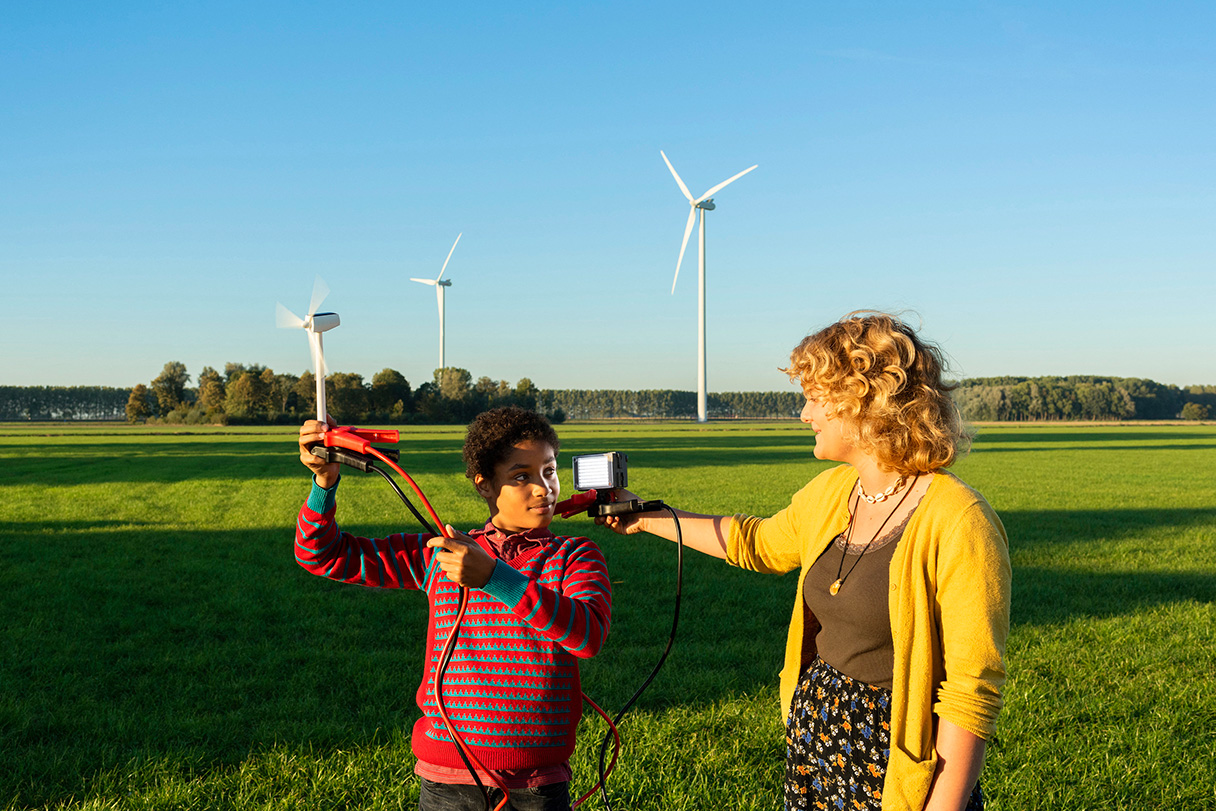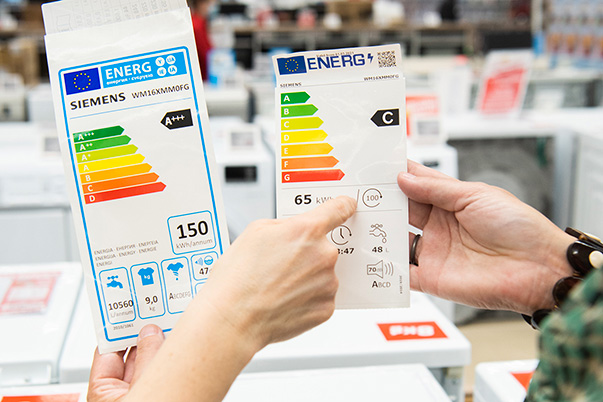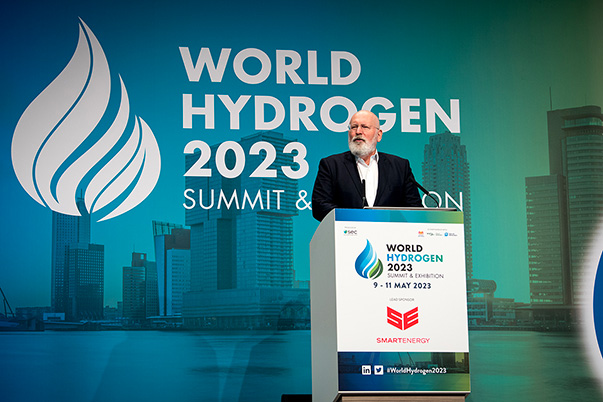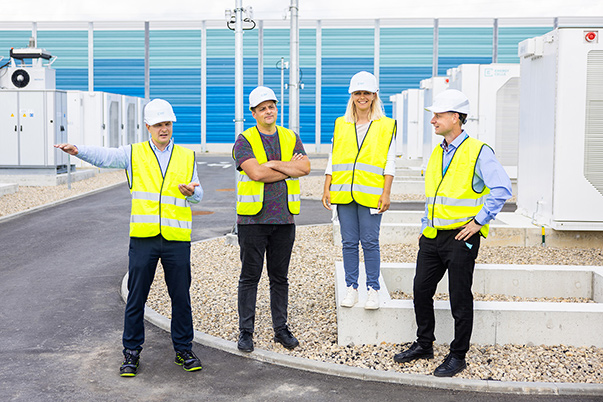
Chapter 4 – Ensuring affordable, secure and sustainable energy for Europe

Introduction
After facing one of the worst global energy crises in decades, in 2023 the European Union took drastic action to save energy, diversify its energy supply and accelerate the clean-energy transition. The continuing climate, environmental and biodiversity emergencies unfolding all over the world further highlighted the need for urgent action. During the year, the EU continued phasing out Russian fossil fuels to safeguard its economy, while making it more sustainable through an increase in renewable-energy production and energy-efficiency measures.
The EU launched a comprehensive reform of its electricity market so that consumers will be better protected against energy price shocks. It also introduced new initiatives to boost its competitiveness and build industrial capacity for clean technologies. These initiatives aim to ensure access to critical raw materials and reduce strategic dependencies in critical technologies and value chains, thereby improving the EU’s economic security and technological sovereignty.
Energy security
Phasing out Russian fossil fuels
To ensure that people in the European Union have access to energy that is affordable, secure and sustainable, the EU launched the REPowerEU Plan - open a new tab. in May 2022. Its objective is to significantly reduce the EU’s dependence on Russian fossil fuels by producing more clean energy at home, reducing energy consumption and diversifying the EU’s energy supplies. Within the first 12 months of its launch, the EU had made substantial progress on these three goals - open a new tab..
By the end of 2023, overall EU imports of Russian gas amounted to just 42.9 billion cubic metres (bcm), compared to 80 bcm in 2022 and more than 150 bcm in 2021. During the year, Norway and North Africa were again the main suppliers of pipeline gas to the EU, while the United States was the main supplier of liquified natural gas.
In addition to REPowerEU, several tools are helping the EU Member States diversify their gas supply. One of these, the AggregateEU - open a new tab. common gas purchasing mechanism, allows gas and gas-consuming companies to band together to pool demand, coordinate on infrastructure use, negotiate with international partners and prepare for joint gas and hydrogen purchases.

A further EU measure to address security-of-supply issues, introduced in 2022, is the Gas Storage Regulation - open a new tab., which requires Member States to fill 90 % of their storage facilities by 1 November to guarantee sufficient stocks for the winter. This measure helped ensure that stocks reached 95 % of capacity ahead of the winter of 2022/2023. With prices substantially lower – and less volatile – than in 2022, progress on filling storage moved particularly swiftly in 2023, reaching the 90 % target on 18 August - open a new tab. and remaining at over 95 % at the start of December.

Several new energy infrastructure projects - open a new tab. completed over the last 2 years have also helped the EU to secure alternative sources of gas supply. Examples include the Baltic Pipe and the Interconnector Greece–Bulgaria, along with new terminals for liquified natural gas in various Member States.
In November, the EU took another step towards making the EU’s energy system fit for the future by publishing the first of its lists of Projects of Common Interest - open a new tab. to be fully in line with the European Green Deal. It is set for formal adoption in early 2024. Published every 2 years, the list - open a new tab. contains projects that will improve the interconnectivity of the Member States’ energy systems. The projects can benefit from accelerated permitting procedures and funding. It is the first list under the revised Trans-European Network for Energy Regulation to exclude fossil fuel projects and include hydrogen and electrolyser projects. It also includes projects that will link the EU’s energy system with the United Kingdom, the Western Balkans and North African countries.

Access to affordable energy
Since summer 2021, energy prices have skyrocketed, severely affecting consumers and putting many at risk of energy poverty. In 2023, the EU focused on introducing rules that reform the energy market to protect consumers against future price shocks. These long-term measures supplement emergency measures taken in 2022, such as the market mechanism that limits excessive gas prices - open a new tab. and an extra contribution - open a new tab. imposed on certain energy companies that are making excessive profits.
Although the EU has a well-integrated single energy market that has benefited consumers for over 20 years, the energy crisis has shown that further improvements are necessary. That is why the Commission presented a proposal in March 2023 to revise the rules of the EU’s electricity market design - open a new tab.. This reform will give consumers more rights and options, while simultaneously increasing their protection by making energy bills independent from the short-term market price of electricity and by making the EU energy market more resilient. The European Parliament and Council reached an agreement - open a new tab. on the reform at the end of the year.
The revised EU electricity market design empowers and protects consumers
Consumers now have the right to:
- fixed-price contracts, allowing them to lock in secure, long-term prices;
- multiple contracts;
- share the renewable energy they produce with neighbours.
- It protects vulnerable customers from disconnection.
- It protects against future market manipulation and energy uncertainty.
- It requires energy suppliers to guard against high price spikes and the risk of failure.

The EU’s efforts to diversify its energy supplies and suppliers have also helped to reduce energy prices – and their volatility – relative to the excesses seen in 2022. The EU Energy Platform - open a new tab. (and specifically the AggregateEU mechanism mentioned earlier in the chapter) pools demand and carries out joint purchases of energy. This translates into better prices for EU consumers.
The Commission has also introduced a mechanism to correct price peaks in the gas market by establishing a new benchmark price for liquified natural gas. This was necessary as an alternative to the previous approach whereby the gas price used by the Dutch Title Transfer Facility was used as a proxy. However, this price was no longer proving reliable as it did not reflect the new market conditions. A benchmark figure is now published regularly by the European Union Agency for the Cooperation of Energy Regulators - open a new tab., showing much less volatility than the Title Transfer Facility price.
Finally, the EU has enabled Member States to directly support vulnerable families and small and medium-sized enterprises through exceptional measures known as SAFE (Supporting Affordable Energy). Falling under cohesion-policy rules - open a new tab., these measures allow Member States to use unspent EU funds under their 2014–2020 allocation to provide direct support to at-risk groups facing increased energy costs.
Efficient use of energy
The energy sector – heating of homes, powering industry sectors, and transport – is responsible for almost three quarters of global greenhouse-gas emissions. This means that reducing energy consumption makes a big difference in the fight against climate change. The EU wants to reduce its emissions by at least 55 % by 2030 (compared to 1990 levels), as set out in the European Green Deal (see Chapter 3).
In the winter of 2022/2023 – thanks to milder weather and the joint efforts of the EU, its Member States, individuals and companies – gas consumption in the EU fell by 18 % (or 53 bcm). However, to keep a careful balance between energy supply and demand, voluntary measures to save energy are still needed. The emergency regulation on reducing gas consumption - open a new tab. (originally agreed in July 2022 - open a new tab.), has therefore been extended. The aim is to reduce consumption by a further 60 bcm between April 2023 and March 2024. Other emergency rules from 2022 on the market correction mechanism, solidarity rules and permitting have also been extended to guard against further problems.

The new Energy Efficiency Directive - open a new tab. has established more ambitious long-term goals for energy consumption
Improving the use of energy in buildings is another important way to save energy. The political agreement on revisions to the Energy Performance of Buildings Directive - open a new tab. in December will help the building sector reduce its energy consumption and make buildings greener. These revisions set out a range of measures to help EU governments boost the energy performance of buildings, with a specific focus on improving the worst-performing buildings.
Energy savings are achieved not only by using less energy and using it more efficiently, but also through the design of everyday products and appliances by manufacturers. The new EU ecodesign rules - open a new tab. specify that electrical appliances should use less energy in standby mode, giving manufacturers 2 years to improve their products’ performance. Tumble dryers, local space heaters, mobile phones, tablets and industrial fans are among the products subject to the new or revised, and stricter, rules. These changes will be reflected in the EU energy label - open a new tab., which continues to be widely recognised and used by consumers in the EU.
The EU aims to make sustainable products the norm. Towards the end of the year, the Parliament and the Council reached an agreement on the Sustainable Products initiative - open a new tab., proposed in March 2022, which challenges the traditional ‘take-make-dispose’ consumption model. The initiative aims to ensure that products are built to last, thereby decreasing waste and conserving resources.

The Commission estimates that reducing the electricity consumption of products in standby mode will save 1.36 million tonnes of carbon dioxide per year. These savings are also good for consumers’ wallets, with the total savings for consumers estimated at €530 million a year by 2030.
Accelerating the production of green energy
Switching to clean, renewable energy is essential to realising the European Green Deal’s goal of a climate-neutral Europe. The REPowerEU Plan, which is central to this transition, focuses on green energy production, phasing out Russian fossil fuels and promoting energy conservation. The Recovery and Resilience Facility - open a new tab. and the Green Deal Industrial Plan - open a new tab. are pivotal in supporting REPowerEU, providing financial and strategic backing for the shift towards renewable energy and the broader goal of a climate-neutral Europe.
The European Green Deal
Making Europe the first climate-neutral continent by 2050

The Green Deal Industrial Plan
Building the industrial capacity for the clean technologies that make up the European Green Deal.
REPowerEU
Responding to energy-market disruption with affordable, secure and sustainable energy for Europe.
The Recovery and Resilience Facility
Recovering from the pandemic and preparing for the green and digital transitions.
The Recovery and Resilience Facility plays a significant role in the financing of green energy projects and infrastructure to accelerate the transition towards renewable energy, with about 42 % of its funds dedicated to the green transition. (See Chapter 2 for more on the facility.) Member States are amending their recovery and resilience plans to include a dedicated REPowerEU chapter, meaning that they will show how they will address its objectives in their recovery plans. To date, 23 Member States have submitted their REPowerEU chapters, with €61.87 billion from the amended plans allocated to renewable energy and energy networks, including €35.51 billion specifically for renewable-energy generation. The Recovery and Resilience Facility also enables Member States to allocate funding to Important Projects of Common European Interest - open a new tab. in areas such as hydrogen and batteries.
In addition to the facility’s support for investment in both mature and innovative renewable-energy technologies, a range of broader initiatives was introduced in 2023 to address the structural challenges affecting the EU’s clean-energy sector. One of these initiatives, the Green Deal Industrial Plan, aims to enhance the competitiveness of net-zero technologies in the EU (thus speeding up the transition to climate neutrality) by building on the strengths of the Single Market. The EU has simplified regulations so that it is easier to obtain the raw materials needed for clean technologies, and has made it easier to obtain funding for green-energy technologies. It is committed to upskilling and reskilling people to work in the clean-technology sector, and to improving open trade to ensure access to raw materials and so that green technologies can thrive. As a result, communities will benefit from the high-quality jobs that the clean-technology industry provides, while individuals will enjoy the advantages of a cleaner environment and a more sustainable market economy.
The Green Industrial Plan is based on four complementary pillars
As part of the Green Deal Industrial Plan – specifically relating to simplifying the regulatory environment for the clean-technology sector – the Commission also introduced proposals in March 2023 for a Critical Raw Materials Act - open a new tab. and a Net-Zero Industry Act - open a new tab.. These two acts will work in tandem to support the EU’s net-zero manufacturing capacity and ensure the availability of necessary raw materials for manufacturing clean technologies in the EU.
Amid global demand for critical raw materials, and in a fast-changing and increasingly challenging geopolitical environment, it is crucial to ensure that the EU has access to a secure and sustainable supply of these materials. This is also essential for the EU’s competitiveness, particularly in sectors such as green and digital technologies and in the defence and aerospace industries.
Formally agreed by the Parliament and the Council in November - open a new tab., the Critical Raw Materials Act will strengthen domestic capacities for critical raw materials throughout the entire supply chain. It establishes clear targets to increase extraction, processing and recycling capacities by 2030. Moreover, the EU will diversify its import sources to avoid relying on any single supplier for more than 65 % of its consumption. This strategy includes forming international partnerships, supported by the Global Gateway - open a new tab..
The Net-Zero Industry Act will strengthen the resilience and competitiveness of the EU’s sector for the manufacturing of net-zero technologies, contributing to a more secure and sustainable energy system. The act will improve conditions for setting up net-zero projects in the EU and attracting investment. It sets an ambitious target: by 2030, the EU’s strategic capacity for net-zero-technology manufacturing should meet or exceed 40 % of the EU’s deployment needs. Achieving this will significantly accelerate progress towards the European Union’s 2030 climate and energy targets and the broader transition to climate neutrality. Moreover, it will boost the competitiveness of EU industry, create high-quality jobs and support the EU’s efforts to achieve energy independence.
Finally, the EU’s aim to speed up the use of renewables, notably those produced in Europe, is also reflected in its energy policy. One of the biggest milestones of 2023 was the revision of the Renewable Energy Directive - open a new tab. to accelerate the roll-out of renewable energy. This revision raised the EU’s renewable-energy target to a minimum of 42.5 % by 2030, with the ambition of reaching 45 %, compared to the previous goal of 32 % set in 2018. The revised directive addresses recent bottlenecks and inefficiencies by introducing new measures on renewable hydrogen and on renewables in transport and industry. It also clarifies technical issues, including sustainability criteria for bioenergy, and makes permanent the previously temporary rules put in place to shorten and simplify the permitting - open a new tab. procedures for renewable-energy projects.
Renewables
After adopting the EU Solar Energy Strategy - open a new tab. and launching the Biomethane Industrial Partnership - open a new tab. in 2022, the EU shifted its focus in 2023 to renewable hydrogen and wind power.
In terms of hydrogen and getting this new technology off the ground, the first step was to define what counts as renewable hydrogen. This was set out in the Hydrogen Delegated Acts - open a new tab., which also stipulated the importance of creating additional renewable energy to produce renewable hydrogen. Setting these EU standards is crucial for the expansion of this sector.
In December, a political agreement on the low-carbon gas and hydrogen package - open a new tab. marked another significant milestone. This initiative is designed to promote the use of renewable and low-carbon gases, with a particular emphasis on establishing a market for renewable hydrogen.

In March, the European Clean Hydrogen Alliance - open a new tab. – set up in 2020 to support the large-scale deployment of clean hydrogen technologies by 2030 – published a roadmap - open a new tab. on hydrogen standardisation. It provides a comprehensive overview of the standardisation gaps, challenges and needs identified by alliance members. The alliance also published a Learnbook on Hydrogen Supply Corridors - PDF file, open a new tab., which provides an up-to-date overview of the evolution of key infrastructure projects across the EU that are required to establish the low-carbon European Hydrogen Backbone - open a new tab.. This is an initiative that aims to make use of both existing and new gas pipelines to create a hydrogen network across the continent.
As regards renewable hydrogen production, the European Electrolyser Partnership renewed its commitment - open a new tab. to the joint declaration - open a new tab. in 2022 on expanding EU electrolyser manufacturing capacity by a factor of 10 by 2025.
The Commission has also proposed to establish a pan-European hydrogen facility, called the European Hydrogen Bank - open a new tab.. The Hydrogen Bank will ensure investment security and business opportunities for European and global renewable hydrogen production. It will do so through two financing mechanisms (one to stimulate EU production of hydrogen, the other for international imports into the EU); by assessing demand and infrastructure needs; and by coordinating different sources of funding for more streamlined investment in sustainable hydrogen.

The Commission signed a joint declaration - open a new tab. with European stakeholders in March to boost research and innovation on renewable hydrogen in order to advance the deployment of renewable hydrogen and drive forward the clean-energy transition.
The EU has also taken action to accelerate the deployment of and innovation in wind power. As opposed to hydrogen power – which is still in its early stages – the EU’s wind-power sector is already a success story. This sector has achieved a levellised cost of energy that is on par with or even below - PDF file, open a new tab. that of fossil fuels, and in 2023 (January to August), wind energy accounted for, on average, 17.2 % - open a new tab. of electricity consumed in the EU. However, some issues remain. Permitting delays, skills shortages and the way in which national tenders are designed to favour cost over sustainability are some of the challenges faced. Moreover, wind turbine manufacturers lack clear wind deployment plans from Member States, complicating project planning amid global competition and commodity cost surges.
To address some of the issues still present in the sector, the Commission presented the European Wind Power Action Plan - open a new tab. in October.
The European Wind Power Action Plan consists of six main parts that address related concerns, and will help wind power capacity grow from 204 gigawatts in 2022 to the desired goal of 500 gigawatts in 2030

The action plan includes the launch of the Accele-RES initiative, which will help digitalise the permitting process and will launch a dedicated online tool to assist with permitting procedures. In addition, the plan will strengthen the competitiveness of the EU’s wind manufacturing industry by making it easier for EU manufacturers to access foreign markets; protect against trade distortions (such as the unfair subsidisation of wind-related products imported into the EU); and standardise wind-energy equipment to improve interoperability, quality and sustainability.
Finally, 21 Member States submitted wind pledges - open a new tab. at the end of 2023, indicating the wind-power projects and wind-energy deployment volumes they envisage for the immediate future (2024–2026). This will create more certainty for both manufacturers and investors, leading to more wind-power projects being launched.

Supporting the transition to renewable energy
Switching to renewable energy also means finding ways to capture and store it for times when, for example, the wind is not blowing and the sun is not shining.
One way to store renewables is by making use of batteries. Since 2017, the European Battery Alliance - open a new tab., set up by the EU to support the European battery ecosystem, has been playing a vital role in supporting progress in this area. Its seventh high-level meeting - PDF file, open a new tab. took place in March 2023, and emphasised the importance of equipping enough people with the skills needed for the battery industry.
Ensuring a just transition and upskilling workers in industries that are affected by the switch to clean energy are other important aspects of making the transition to renewables. Against this backdrop, the European Union designated 2023 the Year of Skills (for further details, see Chapter 6).
In 2023, in addition to addressing specific skills shortages through initiatives like the Wind Power Action Plan, the Commission helped launch a large-scale skills partnership for energy-intensive industries - open a new tab. and a large-scale renewable energy skills partnership - open a new tab.. These partnerships will ensure that the workforces from these industries are equipped with the right skills to keep up with the EU’s transition to renewable energy and help them to navigate the changing labour market. The partnerships aim to both identify skill gaps and develop appropriate curricula and training programmes to address these gaps.
The fisheries and aquaculture sector’s energy transition
In February 2023, the Commission presented a communication on the energy transition of the EU fisheries and aquaculture sector - open a new tab.. The measures under the initiative aim to support the transition of the sector to cleaner energy sources, thus helping to reduce the sector’s current dependence on fossil fuels, which is not only environmentally unsustainable, but also makes it vulnerable to energy price increases. (For further details, see Chapter 3.)

These partnerships also complement existing initiatives, such as the European Battery Alliance Academy - open a new tab., which aims to train, reskill and upskill workers to meet the demand for skilled workers in the rapidly growing European battery value chain. Currently, the academy is developing and rolling out cutting-edge training in cooperation with education and training providers across the Member States.
The Net-Zero Industry Act and the Critical Raw Materials Act have also introduced key initiatives to promote a skilled workforce in the EU. The Net-Zero Industry Act establishes Net-Zero Industry Academies to support the production of net-zero technologies. Similarly, the Critical Raw Materials Act creates a Raw Materials Academy, focusing on enhancing skills that are essential for the workforce in the critical raw materials supply chain.
2023 also saw the launch of the Clean Transition Dialogues. The first - open a new tab. of these focused on hydrogen, bringing representatives of the entire hydrogen value chain together to exchange ideas and best practices on how to strengthen the industrial dimension of the European Green Deal. The second dialogue - open a new tab. took place with representatives from energy-intensive industries.
Finally, to support the switch to renewable energy, the EU is giving practical advice and tailor-made guidance to Member States through the Technical Support Instrument. In 2023, this instrument helped 17 Member States to identify reforms and investments needed to phase out Russian fossil fuels - open a new tab.. The areas of technical support included faster permitting for renewable energy; energy efficiency and building renovation; hydrogen and biomethane production; diversification of gas supply; and industry decarbonisation. This support will contribute to achieving the green transition and reducing the price of energy, to the benefit of individuals and businesses.








